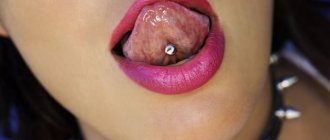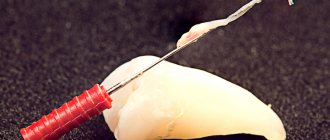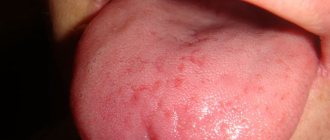Tongue piercing: to do or not?
Before getting a tongue piercing, you may want to consider broken teeth, drooling, gum and nerve damage, loss of taste, tooth loss, or infections.
All of these problems can result from this procedure. People who have had piercings often develop cracks in their tooth enamel. This occurs due to constant mechanical trauma to the teeth during eating, sleeping, or talking.
The crack may be limited to the enamel of the tooth and require a filling, or it may extend deep into the tooth, in which case endodontic treatment (root canal treatment) or tooth extraction will be required.
We often have to deal with infections. It is known that oral infections can spread to other organs and systems of the body. The surface of the tongue is covered with bacterial plaque. When the tongue is pierced, bacteria enter the bloodstream. Once this happens, the bacteria can travel through the bloodstream, causing a number of serious problems, one of them being endocarditis (inflammation of the heart or its valves).
Tongue piercing is a potential risk factor for the transmission of herpes simplex virus and hepatitis B and C.
When carrying out this procedure (tongue puncture), complications cannot be excluded: nerve damage, prolonged bleeding, which results in numbness of the tongue or loss of sensitivity at the puncture site, or limitation of movement. If blood vessels have been damaged, prolonged bleeding may occur. Swelling of the tongue associated with a piercing can be severe enough to cause blockage of the upper respiratory tract and make breathing significantly more difficult.
Inflammation of the gums. People with barbell piercings are at greater risk of gum disease than people without oral piercings. Jewelry can come into contact with gum tissue, causing damage or recession, which can lead to loose teeth or tooth loss.
Difficulties appear in everyday speech functions.
A tongue piercing can cause difficulty chewing and swallowing food, and may also interfere with clear speech. This happens because jewelry provokes increased salivation.
Temporary or constant drooling is another consequence of excessive saliva production. A change in taste may also occur.
Allergic reactions to metal. A hypersensitivity reaction to metal in jewelry, often called allergic contact dermatitis, can occur in some people. Inhaling jewelry. Jewelry that is not securely secured in the mouth can pose a choking hazard and, if swallowed, may cause injury to the esophagus or lungs.
Tongue piercing can be one of the causes of tongue cancer, as this organ is traumatized.
If you do decide to pierce your tongue, take care of it very carefully. After the piercing, the tongue heals within four to six weeks. In order to avoid complications, the jewelry can be removed for a short time so that the puncture site does not close. Always remove jewelry when eating or sleeping.
To avoid serious infections such as HIV or hepatitis, make sure the piercer uses sterile instruments. Find out all the questions related to aftercare, hygiene and anything else that worries you.
Prepared by: dentist Arefieva Yu.V.
Piercing as a source of pain
If we talk about the degree of pain of the procedure itself, then performing a tongue piercing is not a pleasant event. If a person becomes very nervous and twitches, causing the specialist to be unable to make an accurate puncture, everything will end with serious damage to an important organ. Therefore, many salons and medical institutions offering this service recommend using local anesthesia. Today, both injection and superficial methods of administering anesthetic are widely used.
Will my tongue hurt after a tongue piercing?
On a note! When choosing piercing under anesthesia, get ready for the fact that in the first couple of hours you will not have the opportunity to express yourself normally, since your tongue is unlikely to obey you. It is better to make sure in advance that someone you know is next to you. The effect of “freezing” will completely wear off only after 1-1.5 hours.
After the piercing, the tongue will still hurt and cause discomfort for some time. To relieve pain, you can take a painkiller tablet. This organ contains a huge number of blood vessels and nerve endings, so for another 2-3 weeks you will feel some soreness and swelling of the soft tissues. Be careful: if it doesn’t get better, the pain intensifies, becomes pulsating, you should see a doctor as soon as possible. Possible complications in this case include an allergic reaction to the metal and infection of the wound.
Side effects of piercing
The side effects that can occur after getting a piercing are numerous. Incorrect installation of piercings in both the upper and lower lips can lead to irreversible consequences, such as damage to the facial nerve. Also, the piercing procedure itself guarantees inevitable swelling and bleeding.
Regular contact of metal parts with tooth enamel leads to its damage, this can be either minor microcracks or severe chips. In fact, the teeth of a person who has had an oral piercing are constantly injured 24 hours a day. When you talk, chew, or simply move your tongue, the hard metal earring continually damages your tooth enamel.
After some time, tiny cracks invisible to the human eye develop into quite serious problems. There is increased sensitivity of the teeth to irritants such as cold, heat and acids. Constant irritation of the nerve leads to caries.
Due to the occurrence of galvanic currents between the metal of the earring and other metals in the mouth, severe irritation of the pulp can occur. Plus, this is facilitated by the acidic environment in the mouth.
Piercing also entails a change in the normal function of the oral cavity. Foreign objects, particularly jewelry in the mouth, can trigger excessive saliva production, which can significantly affect the clarity of pronunciation, as well as chewing and swallowing food. This is not particularly convenient in everyday life.
Piercing under tongue
The piercing is also done on the frenulum of the tongue. This is a type of piercing in which the cut occurs through the tissue of the frenulum, which is located under the tongue itself. This is a simple and uncomplicated procedure, but after a while some people experience rejection due to anatomical features. But not everyone can get this type of piercing. Again due to anatomical features. Why do experts prefer to insert a barbell? Because this type of decoration is a more convenient form. Also because the barbell is considered a classic piece of jewelry. True, others can also be used, for example, metal bends, rings, earrings, and various studs.
Reasons for pain
The following factors can cause characteristic tongue pain:
- Organ injuries.
- Inflammation.
- Allergy.
- Neurological disease.
- Pathologies of internal organs.
- Tumor formation.
- Blockage of the salivary gland.
The most common cause of pain on one side of the tongue is damage to it. As a rule, this is noted during meals. Injuries may include burns, pinching, or scratches. As a result, pain can occur on the upper part, under the tongue or in its side.
Also, a muscular organ can hurt due to a chipped layer of tooth enamel, tingling from the sharp edge of a filling, or prosthetics performed with violations. With mechanical influence, increased pain is noted. In a situation where a patient has difficulty swallowing, and there is also discomfort in the throat or palate, there is a need to visit a doctor and ask him why this is happening.
You should pay attention to the nasopharynx, since as a result of its damage, one sign may appear - swelling of the lymph nodes under the tongue. Many parents are puzzled by the question of why a child’s tongue may hurt at its base, as well as its side, accompanied by plaque and pain when swallowing
But only a qualified doctor can help resolve this issue due to the possible presence of purulent sore throat, which requires immediate administration of adequate therapy
Many parents are puzzled by the question of why a child’s tongue may hurt at its base, as well as its side, accompanied by plaque and pain when swallowing. But only a qualified doctor can help resolve this issue due to the possible presence of purulent sore throat, which requires immediate administration of adequate therapy.
An allergic reaction often occurs due to the fault of certain products, as well as medications. Moreover, signs may appear immediately after their adoption. Some fruits, berries, smoking and alcohol can serve as provocateurs. Neurological disease glossalgia, which arises under the influence of a malfunction of the endocrine system and neurotic disorders. So, a sick person may experience burning, tingling and numbness of the organ.
Diseases of internal organs of unknown etiology often cause pain. All this happens due to various changes in human health, since the tongue reacts sharply to any ailments of an infectious nature - glossitis, as well as pathologies of the gastrointestinal tract, cardiovascular system and even anemia.
Oncological lesions often create conditions for the tongue to begin to hurt on the right or left side. Because of this, the pain syndrome is localized inside the tongue. Moreover, the nature and intensity of pain directly depends on the stage of the malignant disease. In this case, the patient is referred to an oncologist.
When should you see a doctor?
You should consult a doctor if signs of infection develop
Qualified medical care should be sought if:
- there are signs of infection, such as fever, severe pain, new swelling, or enlarged lymph nodes in the neck;
- symptoms of infection do not subside several days after starting treatment;
- the site of tissue damage constantly bleeds;
- green or yellow pus is released from the site of injury;
- there is an unpleasant odor from the mouth;
- toothache or swollen gums;
- swelling develops or tissue growths form anywhere in the oral cavity.
In addition to meeting with your doctor, you can also visit a piercer and get recommendations on how to relieve pain and other symptoms.
Many piercers give their clients tips to speed up healing and ease discomfort.
However, it is important to understand that consultations with a piercer cannot replace the advice of a doctor.
Failed tongue piercing: the consequences can be catastrophic
It is clear that, first and foremost, we are talking about unsuccessful punctures, after which negative consequences most often arise. However, you can always fight them, allow the wound to heal completely, and then start all over again. It is worth understanding that if the swelling does not go away within two weeks, and even more so if the tongue has acquired an unnatural, for example, bluish tint, then you have a direct path to a surgeon who will continue to solve your problems with the piercing. But what other signs indicate that it’s time to run to the doctor?
Photo from the site: liveinternet.ru
- If you constantly feel unbearable pain, itching, and burning in the tongue area. Such sensations are possible in the early stages after the puncture, but then they should completely pass.
- An unnatural red and inflamed area of the tongue around the stud is a clear sign of an inflammatory process.
- An unpleasant, or even more so, foul odor from the mouth is a sign of bad news.
- Also, discharge of any kind from the canal and puncture may be a bad sign.
- Pay attention to your general well-being. If your temperature is constantly elevated, then most likely the wound is inflamed.
It is necessary to understand that, among other things, you need to closely monitor all this, since it is quite possible that strong antibiotics will be needed as treatment. It is also worth understanding that “prescribing” such drugs to yourself is extremely risky, so a visit to the doctor is simply inevitable. You also need to know that you have to pay for beauty; for example, chips of tooth enamel often occur due to mechanical damage. That is, the bar will hit the teeth and cracks cannot be avoided. Candidiasis can also often appear with improper care, and even rejection of a foreign body by the body.
Original and provocative tongue piercing: pros and cons, how it will be
It is worth understanding what it is to decorate your own body, it is far from easy, and you will have to make this decision if you really want to have such an original accessory in your mouth as a stud bar. Moreover, few people realize that tongue piercing, the consequences of which may not be pleasant, to put it mildly, also has a secret sacred meaning. The first such punctures were invented by the ancient tribes of American Indians, who, with its help, performed special rituals to reunite their divine nature with their human nature.
Need to know
The tongue piercing operation is virtually painless and is most often performed without the use of anesthesia or any anesthetics. However, the healing process can be quite painful. For example, you will have to switch to liquid food for a while, give up a lot of things that you are used to, so you should think carefully about everything in advance before agreeing to the procedure.
However, the secret meaning of this action has been completely lost over the centuries, and modern fashionistas and fashionistas are already doing tongue piercing for completely different reasons
Each of these reasons may have their own, but the most common is, of course, giving special pleasure to the partner in terms of sex, and this is an important factor that, of course, must be taken into account
When understanding how tongue piercing is done, the pros and cons of this process should be taken into account first and foremost. First of all, so as not to get serious consequences, and they really can appear soon. It is worth understanding that the puncture procedure can only be carried out by a real professional in the salon. You should not go to his home or invite the master to your place, because it is quite difficult to provide decent conditions for this process.
Possible complications
Below we will look at the main disadvantages of tongue piercing for the oral cavity. All of the listed consequences of this procedure are not “rare exceptions”, but on the contrary, they appear in most cases.
- Infection. Believe it or not, an incredible amount of bacteria accumulates in the mouth. As a result of their vital activity, swelling and inflammation may develop at the puncture site, and an infection may develop. If not treated immediately, the infection can become life-threatening. Another, possibly unexpected complication is tongue swelling. A swollen tongue can block the airway and cause suffocation.
- Damage to teeth and gums. People who bite and play with their piercings run the risk of damaging and weakening their gums. Weakened gums eventually lead to loosening and tooth loss. In addition, this addiction sometimes leads to cracks in tooth enamel and damage to fillings, especially if a person has sensitive enamel. One study found that nearly half of people with a ball-shaped tongue jewel that had been in their mouth for more than four years had at least one chip on their tooth.
- Allergic reactions. People with particular sensitivities to metals are at risk of developing allergies as a result of piercings.
- Numbness. Sometimes people experience numbness after a tongue piercing due to nerve damage. Fortunately, this complication is temporary, but in rare cases it does not go away. Nerve damage can make it difficult to move your mouth and affect your sense of taste.
- Increased salivation. Tongue piercing leads to excessive salivation, impaired diction, difficulty chewing and swallowing food.
- Dental x-rays are difficult. Piercings can make dental examinations difficult because jewelry blocks or distorts X-rays. As a result, you have to “reshoot” several times to achieve a good image.
Treatment with medical and folk remedies
If the root cause when the tongue begins to hurt is identified as stomatitis, then, as a rule, the specialist prescribes a cycle of antibiotics and treatment of the oral cavity with antiseptic drugs - Miramistin or Chlorhexidine.
If the stumbling block is a disease of the endocrine system, then hormonal treatment is prescribed; as a rule, the problem is determined by diabetes. In a situation where ailments unrelated to dentistry are identified, only one or several qualified specialists can prescribe drug treatment. Traditional methods of treatment can be used if the source of pain does not have serious reasons.
Then, to stop your tongue from hurting, you can rinse with a salt or soda solution, and also hold the oil from sea buckthorn seeds for a while without swallowing.
To exclude such signs, it is important to carefully monitor the hygienic condition of the oral cavity by regularly brushing your teeth and tongue, not forgetting about timely examinations by the dentist, so that you do not end up having to treat the entire body. The main aspect in the implementation of therapy is the impact on the internal part of the body and the implementation of treatment at the local level
The main aspect in the implementation of therapy is the impact on the internal part of the body and the implementation of treatment at the local level.
Advantages and disadvantages
The presence of an earring in a person's tongue always attracts everyone's attention to him. The corresponding procedure can be treated both badly and well
But almost always the presence of a puncture arouses interest among others.
Anyone who agrees to have their tongue pierced feels special, different from everyone else. In this way a person wants to show his individuality. And some people decide to get piercings in order to show their decisive character or, conversely, to overcome themselves.
Pros of a puncture
- After the procedure, a person begins to consider himself liberated, courage and determination appear in his character. Anyone who decides to have their tongue pierced “challenges” a monotonous and boring life.
- Tongue piercing is not as noticeable to others as, for example, eyebrow piercing. If necessary, the “decoration” can be removed, and no one will notice the presence of a puncture.
- Improves sexual sensations for a partner. When kissing or performing oral sex, tongue piercing can add additional sexual arousal and add a sense of exoticism to sexual contact.
- After surgery, a long recovery period is required. At this point, you need to follow a strict diet and give up a large list of foods. This restriction helps some people lose weight.
- If all the basics of proper care are followed, the risk of complications is minimal.
- The ability to remove the “decoration” at any time and ensure that the tongue piercing is healed. Thanks to active regeneration of soft tissues, the puncture heals very quickly.
Flaws
- The procedure is very painful. If a person is very sensitive to pain, then it will be difficult for him to undergo such an operation.
- The recovery period, which can “stretch” for several months, also brings a lot of inconvenience. The healing process of the wound surface provokes pain and physical discomfort. It can take from 3 to 6 months before all the unpleasant sensations end.
- Piercing needs to be done only in a specialized clinic or salon, and always by an experienced and qualified master. Many people pierce various parts of the body at home. But in this option, the risk of developing dangerous complications increases sharply. Saving on your own health can cost much more than the cost of surgery in a trusted clinic.
- There is a risk of infection. This often occurs due to the use of unsterile instruments during surgery. The development of infection is not the worst complication of piercing. Complications include hepatitis and herpes. The likelihood of developing complications dangerous to health increases significantly if the procedure is performed by inexperienced or unqualified professionals.
- Tongue piercing almost always damages teeth. This occurs due to the fact that a person has a desire to “chew” or bite the earring. Teeth begin to deteriorate and break for another reason - while chewing food, an unintentional biting of a metal rod occurs.
- If you have a tongue piercing, careful care of your teeth and gums is required. Many young girls and boys, in order to boast about the presence of “decoration” in their mouth, show it off to others who touch the barbell with their hands. All this causes an increase in the number of bacteria and pathogenic microorganisms in the oral cavity.
- Development of gum disease.
- The presence of a foreign body in the oral cavity often provokes the development of discomfort - redness of the mucous membrane, itching, the desire to scratch the tongue.
Pros of piercing
- Through piercing a person liberates himself and tries something new in life.
- A girl's tongue piercing looks very sexy and also gives new sensations during kissing.
- During healing, you will need to adhere to a strict diet, with which you can even lose a couple of extra pounds.
- Low pain due to the needle passing between the muscle fibers.
- There is very little chance of getting an infection due to the antimicrobial properties of saliva.
You can find and identify for yourself several more advantages of tongue piercing, which consist, for example, in the beauty of this procedure.
Now let's move on to the disadvantages, which are also important and even necessary to familiarize yourself with before getting a piercing.
How is it done and how long does tongue piercing take to heal?
First, let's figure out how the procedure itself occurs so that we know in detail what to expect. Thorough preparation is what can guarantee a good result, as well as a proper healing process.
In the salon, the master must use a special clamp, which has a hole for a puncture. He clamps the tongue in a clamp and pierces it using a special sterile needle.
Moreover, it is better if the needle is disposable, as there is much less chance of getting an infection, and this is very important. Next, the master, through a special hole in the needle itself, inserts the stud bar directly into the tongue, after which both the clamp and the needle are removed. After the procedure, you must rinse your mouth with any disinfectant solution. An excellent option would be Chlorhexidine diluted in a ratio of one to four with water.
Around evening, the tongue will definitely swell and you will have to put up with such inconvenience, as this is inevitable. Healing may occur at different rates in different people, and depending on the quality of the tongue piercing procedure. It can be over in five days, or it can take two weeks to heal. Moreover, for this entire period you will have to completely abandon hot spices, acids, and, in general, solid food. It is also recommended to talk less in the first days, as you can easily injure the wound.
How it's done
Since tongue piercing is a surgical procedure, it is necessary to approach the issue of choosing the location for the procedure with all responsibility. You need to remember that this is not something you can save money on. Tongue piercing can only be done by professional piercers who are licensed to perform the procedure.
Under no circumstances should you perform the piercing yourself, otherwise you risk causing complications that will require surgery.
First, the specialist interviews and conducts a thorough examination of the client. Identifies possible contraindications, warns of possible problems and gives recommendations to the patient.
If you take all recommendations responsibly and care for your piercing properly, you can avoid unwanted symptoms.
Tongue piercing takes a few seconds, but despite this, it is a painful but tolerable process and is performed without anesthesia. To minimize the risk of complications and avoid negative consequences:
- it is necessary to carefully observe the rules of asepsis;
- the procedure should be carried out only with a professional clamp with a hole for a puncture; accordingly, a special needle is inserted through it;
- it is necessary to select the correct material for the bar to eliminate possible allergic reactions in the patient;
- Follow all the recommendations of the specialist for caring for the oral cavity after piercing.
If the piercing is successful, healing is quick and painless.
Risks
In general, tongue piercing is a fairly safe procedure. The biggest risk it poses is infection of the wound soon after the healing process begins. However, most infections are mild and can be easily treated with oral antibiotics.
However, sometimes people develop severe infections, such as abscesses. In such situations, the person may require hospitalization or intravenous antibiotics.
In addition, piercing is associated with the following risks:
- damage to teeth and gums;
- gum recession on the inside of the mouth;
- Ludwig's tonsillitis is a rare type of skin infection that develops under the tongue.
- Accidental ingestion of jewelry, which may result in choking or throat damage;
- acquiring diseases such as tetanus or HIV if the piercer uses unsterile instruments or jewelry that has already been used before.
- spread of infection to the blood or other organs (rarely observed).
In some cases, the body rejects the piercing, which can lead to further complications.
Variety of earring options for men
For vertical piercing, as well as for ear-to-ear piercings, only a barbell is used.
For superficial piercings, use a regular barbell or a barbell bent to accommodate a plane puncture. Segment rings or with ball-shaped clasps can also be used. They are also used for the tip. But spirals with circular shapes can also suit him.
For the frenulum of the tongue, horseshoes or a banana are used.
Stages of the healing process
After a tongue piercing, it usually takes 4–6 weeks to heal
Each person's body has its own individual characteristics, so the healing process occurs differently in different people. If your immune system is weak, which may be due to diabetes, cancer, HIV, or certain medications, recovery takes longer and the body is usually more susceptible to infections.
Typically, after a tongue piercing, healing goes through the following three stages.
1–3 days after the procedure
Immediately after the piercing, the wound may be irritated and painful. In addition, people often experience discomfort when pronouncing words due to the fact that they cannot yet get used to a foreign object in the oral cavity.
However, during this period it is important not to touch the tongue with your hands or teeth, as this may increase irritation.
Initially, it makes sense to try to place food on the teeth to chew it, and some people prefer to eat shakes or other liquid foods for the first few days.
During this time, it is also important to rinse your mouth with a saline solution several times a day. Piercers recommend preparing them by diluting a quarter teaspoon of iodine-free salt in a glass of warm water.
You should not use more concentrated solutions or creams with antibiotics unless your doctor recommends this. Additionally, it is important to follow the instructions provided by the piercer.
It is also recommended to use a new toothbrush after piercing to reduce the risk of harmful bacteria entering the damaged area.
Swelling and inflammation. From 4 to 10 days
Within a few days after the piercing, swelling of the tongue usually increases. This symptom usually lasts up to a week or a little longer. The wound may bleed or ooze
It is important to understand that minor bleeding usually does not indicate serious problems, but if the blood flows constantly, then you should consult a doctor. A few days after the procedure, wounds often begin to ooze a whitish or clear fluid.
When the swelling subsides, you need to replace the jewelry with a shorter one, since long pieces exacerbate irritation and can damage your teeth. Ideally, jewelry changes should be performed by a piercer.
Always wash your hands thoroughly before touching the piercing.
It is also important to use only new and sterile jewelry for insertion into the tongue.
During this period, the risk of developing infection is very high.
It is important to know that its dangerous symptoms include the following:
- severe swelling;
- growing pain;
- fever;
- pus coming out of a wound.
Early healing. From 10 to 30 days
Piercing wounds heal from the outside in, meaning the outer tissue of the tongue is initially restored. Therefore, even when the damaged area begins to seem less irritated, it may actually take several more weeks for complete healing.
At this stage of the healing process, the wounds usually become less painful, but the person may still need time to get used to the foreign object in the mouth.
Typically, the tongue heals quickly, which means that soon after the jewelry is removed, the tissues of the tongue can come together.
Scarring and complete recovery. From 4 to 6 weeks
Essentially, a piercing is a scar, and it takes the body some time to form it.
In the absence of complications, complete healing usually occurs in 4–6 weeks. If, after a month, swelling continues to be observed in the tongue, as well as in cases where, after apparent healing, swelling and soreness occur again, the person may develop an infection or other problems.
Consequences
If you went to an experienced doctor, then with proper treatment and care there will, of course, be no serious consequences. But an unsuccessful piercing may be accompanied by heavy bleeding if an artery is damaged or an unnatural color of the tongue. Improper puncture is harmful to your health, so in such a situation you should consult a surgeon.
Possible consequences of tongue piercing:
- Purulent discharge.
- Discomfort, burning sensation and almost unbearable pain.
- Unpleasant smell.
- A piece of jewelry that doesn't suit you can grow into your tongue, which will interfere with normal conversation.
- Paralysis of some muscles of the oral cavity, including the tongue.
- Violation of tooth enamel and gums, teeth become more brittle and weaker.
Quite unpleasant consequences, right? Be careful about yourself and your choice of piercer to prevent this from happening.
Which metal jewelry should you prefer?
For the first time after surgery, it is recommended to wear simple jewelry that is not framed with stones or patterns. Select the following material:
- Hypoallergenic plastic.
- Can be replaced with Teflon.
- If gold, then only high standard - 585 or 700.
- You can use surgical implant metal, but then replace it with a more expensive material.
When the hole is completely healed, you can afford another decoration. For lips, try to give preference to hypoallergenic materials. They have high biocompatibility with human skin and tissues. Moreover, they do not irritate the mucous membrane. In addition to standard metals, these can be amber, wood, niobium and even ivory.
Despite the widespread use of surgical metal products, you should not wear them immediately after a piercing. Due to the high concentration of nickel, such earrings often cause complications and suppuration of wounds.
Piercing: advice from dentists
You already know the attitude of dentists towards piercing! But what to do: if your lip and tongue are already pierced, and you decide to keep up with fashion? How can you reduce the risk of oral piercings to your teeth and gums?
- Dentists recommend installing plastic ones instead of classic metal jewelry. This material is much softer, which means that the risk of causing damage is much lower. But plastic products also have their disadvantages. For example, today it is not known exactly which types of plastic cause allergic reactions, while, for example, titanium is a completely hypoallergenic material.
- It is better to remove jewelry before eating or going to bed. For this purpose, there are special plugs that allow you to compensate for the product during sleep.
- When piercing the tongue, it is better to remove the jewelry before going to bed or while brushing your teeth. This can be done after the wound from the piercing has completely healed.
- After each meal, it is advisable to rinse your mouth with a special antiseptic solution.
- Injury to teeth and gums can be avoided by removing the piercing before any vigorous activity.
The meaning of piercing
Piercing is a form of modification of any part of the body with soft skin tissue in order to insert jewelry there. Thus, the individual wants to emphasize her beauty and receive aesthetic pleasure. They use such decorations as labrets, rods, tunnels, studs and rings, but that’s not all! The most common facial piercings are eyebrow, lip, nose and tongue piercings. Piercings are also done on the navel and private parts of the body. The very concept of “piercing” can imply both the piercing process and the hole itself. Below are photos of tongue piercings and other types of punctures.











